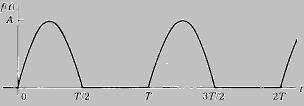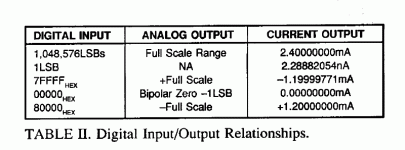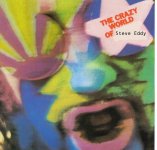How can anyone take Bedini seriously?????
I have an original press release for that log that we received.
It is dated Feb. 31, 1991.
I thought that April Fool's Day had come early that year.
(For those who don't believe me......I think I still have it somewhere. Just don't make me look for it. Take my word this time.)
Jocko
I have an original press release for that log that we received.
It is dated Feb. 31, 1991.
I thought that April Fool's Day had come early that year.
(For those who don't believe me......I think I still have it somewhere. Just don't make me look for it. Take my word this time.)
Jocko
Re: Binary two's complement
Ok, so let's work it out.
Instead of being able to swing a full 6 volts, you can only swing (+2.999908) - (-3.000000) or 5.999908 volts. Maximum quantization noise is still going to be +/-1/2LSB. 1/2LSB here will be 0.000046 volts (0.000092/2) and since we're looking at a peak-to-peak signal swing, peak-to-peak quantization noise will be (+0.000046) - (-0.000046) or 0.000092 volts.
Going back to the triend and true definition of dynamic range as being the ratio of the noise floor to the maximum signal, we get:
20 x log (0.000092/5.999908) = 96.287135dB
If we were able to swing the full 6 volts, we'd get a dynamic range of:
20 x log (0.000092/6) = 96.287268dB
For a difference of 0.000133dB.
Yes?
se
Fred Dieckmann said:From Burr Brown data sheet
Ok, so let's work it out.
Instead of being able to swing a full 6 volts, you can only swing (+2.999908) - (-3.000000) or 5.999908 volts. Maximum quantization noise is still going to be +/-1/2LSB. 1/2LSB here will be 0.000046 volts (0.000092/2) and since we're looking at a peak-to-peak signal swing, peak-to-peak quantization noise will be (+0.000046) - (-0.000046) or 0.000092 volts.
Going back to the triend and true definition of dynamic range as being the ratio of the noise floor to the maximum signal, we get:
20 x log (0.000092/5.999908) = 96.287135dB
If we were able to swing the full 6 volts, we'd get a dynamic range of:
20 x log (0.000092/6) = 96.287268dB
For a difference of 0.000133dB.
Yes?
se
Re: How can anyone take Bedini seriously?????
Hehehe. Remember the RainTinge ad that came out I think in an April issue of Stereophile?
se
Jocko Homo said:I have an original press release for that log that we received.
It is dated Feb. 31, 1991.
I thought that April Fool's Day had come early that year.
(For those who don't believe me......I think I still have it somewhere. Just don't make me look for it. Take my word this time.)
Hehehe. Remember the RainTinge ad that came out I think in an April issue of Stereophile?
se
10 will get me 20
The minimum AC signal the DAC can swing is 1 bit positive to 1 bit negative. Anyone who thinks the signal below is a sine wave should be happy to give me a 20 dollar bill in exchange for a ten using the same rational. Any takers? I hope that doesn't leave the least significant twit in a dither....
The minimum AC signal the DAC can swing is 1 bit positive to 1 bit negative. Anyone who thinks the signal below is a sine wave should be happy to give me a 20 dollar bill in exchange for a ten using the same rational. Any takers? I hope that doesn't leave the least significant twit in a dither....
Attachments
Could you explain to me the reason why a DAC cannot swing from 0 to +1 LSB? Or the converse? My data books don't indicate that this is a restriction. Nor does the Burr Brown sheet you've posted.
The drawing you show does not represent what happens when you do the 1 LSB swing and then run through the anti-imaging filter. But I'm sure you knew that. Nonetheless, the comedic effect could give people the wrong idea.
The drawing you show does not represent what happens when you do the 1 LSB swing and then run through the anti-imaging filter. But I'm sure you knew that. Nonetheless, the comedic effect could give people the wrong idea.
In all seriousness. . .
. . . you guys can really play with the uninformed guy's head!
I followed the conversions from binary to base 10 (and hex, just for fun?) and understand the elementary version of how this corresponds to the -1 to +1V analog, but, being a young ME who has only the experience of 1 semester's (voluntary) coursework with an intro to digital electronics, I am easily lost between fact and tongue and cheek. Having said that, I am a fan of both Steve and Fred's brand of humor, but often it just goes over the ol' head.
If anybody can suggest a somewhat readable textbook which would make me more comfortable in reading the digital section of this forum, I'd be glad to take the challenge and hopefully at least be a lurker here in the future. Honestly, though, you guys just scare me on occasion. After that, for dichotomy, a book on analog amplification might help me be able to view posts in the tubes forum. For clarification, I don't plan on being a contributor to either fora, as I think there is experience in both which I could not match with simple learning.
Help!!!
Sandy.
. . . you guys can really play with the uninformed guy's head!
I followed the conversions from binary to base 10 (and hex, just for fun?) and understand the elementary version of how this corresponds to the -1 to +1V analog, but, being a young ME who has only the experience of 1 semester's (voluntary) coursework with an intro to digital electronics, I am easily lost between fact and tongue and cheek. Having said that, I am a fan of both Steve and Fred's brand of humor, but often it just goes over the ol' head.
If anybody can suggest a somewhat readable textbook which would make me more comfortable in reading the digital section of this forum, I'd be glad to take the challenge and hopefully at least be a lurker here in the future. Honestly, though, you guys just scare me on occasion. After that, for dichotomy, a book on analog amplification might help me be able to view posts in the tubes forum. For clarification, I don't plan on being a contributor to either fora, as I think there is experience in both which I could not match with simple learning.
Help!!!

Sandy.
Re: In all seriousness. . .
I'd recommend Ken C. Pohlmann's Principles of Digital Audio, ISBN 0-07-134819-0.
se
Sandy H. said:If anybody can suggest a somewhat readable textbook which would make me more comfortable in reading the digital section of this forum, I'd be glad to take the challenge and hopefully at least be a lurker here in the future.
I'd recommend Ken C. Pohlmann's Principles of Digital Audio, ISBN 0-07-134819-0.
se
My turn to pour gasoline on the fire....
This is directly from the '1702 data sheet......the oldest DAC that I have data on.
I assume that we don't have any Second Class Telephone Sanatizers here, and that everyone can do the math themselves.
(I really love these food fights......livens up an otherwise slow day.)
Jocko
This is directly from the '1702 data sheet......the oldest DAC that I have data on.
I assume that we don't have any Second Class Telephone Sanatizers here, and that everyone can do the math themselves.
(I really love these food fights......livens up an otherwise slow day.)
Jocko
Attachments
What are you guys up to, posting a lot of DAC data? They just
show what we already know, that the output voltage/current
is a linear function of the digital input. Sure, it tells what the
constant is for a particular DAC, but that is irrelevant to the
qusstion of dynamic range of the digital medium.
show what we already know, that the output voltage/current
is a linear function of the digital input. Sure, it tells what the
constant is for a particular DAC, but that is irrelevant to the
qusstion of dynamic range of the digital medium.
I wonder how many bits can dance on the head of a pin?
"Sure, it tells what the constant is for a particular DAC, but that is irrelevant to the
qusstion of dynamic range of the digital medium."
Gee I always thought you had to run the digital audio through a DAC to hear or measure the analog signal. If some one has found a way to listen to the data direct I would be very interested !!!!
http://www.straightdope.com/classics/a4_132.html
"Sure, it tells what the constant is for a particular DAC, but that is irrelevant to the
qusstion of dynamic range of the digital medium."
Gee I always thought you had to run the digital audio through a DAC to hear or measure the analog signal. If some one has found a way to listen to the data direct I would be very interested !!!!
http://www.straightdope.com/classics/a4_132.html
Re: I wonder how many bits can dance on the head of a pin?
Really Fred, now you sinking below the level of stupidity
you accuse others of. Of course you need a DAC, but if it
swings 1 V or 100 V is not important for the information content
of its input.
It does play a role when we take noise etc. in the D/A conversion
into account, but I don't think we were discussing such
DAC-specific things, but rather the inherent information
properties of the CD standard.
BTW, it always puzzles me how prompt you are at providing
links, diagrams etc, but almost never say anything about your
own interpretations and conclusions of them.
Fred Dieckmann said:"Sure, it tells what the constant is for a particular DAC, but that is irrelevant to the
qusstion of dynamic range of the digital medium."
Gee I always thought you had to run the digital audio through a DAC to hear or measure the analog signal. If some one has found a way to listen to the data direct I would be very interested !!!!
http://www.straightdope.com/classics/a4_132.html
Really Fred, now you sinking below the level of stupidity
you accuse others of. Of course you need a DAC, but if it
swings 1 V or 100 V is not important for the information content
of its input.
It does play a role when we take noise etc. in the D/A conversion
into account, but I don't think we were discussing such
DAC-specific things, but rather the inherent information
properties of the CD standard.
BTW, it always puzzles me how prompt you are at providing
links, diagrams etc, but almost never say anything about your
own interpretations and conclusions of them.
Steve Eddy,
loved the humour. I have tried talking sternly to electronics, but it is as effective as talking sternly to a cat. (Statistically insignificant.)
Talking of statistics, what nobody has mentioned is that dither is a statistical process, so it only increases resolution on repetitive signals, and that distortion analysers (whether analogue or digital) effectively average over a number of samples. If you have access to a digital oscilloscope, you can prove this concept to yourself by adjusting the number of screen captures for averaging while looking at a noisy sine wave.
loved the humour. I have tried talking sternly to electronics, but it is as effective as talking sternly to a cat. (Statistically insignificant.)
Talking of statistics, what nobody has mentioned is that dither is a statistical process, so it only increases resolution on repetitive signals, and that distortion analysers (whether analogue or digital) effectively average over a number of samples. If you have access to a digital oscilloscope, you can prove this concept to yourself by adjusting the number of screen captures for averaging while looking at a noisy sine wave.
EC8010 said:loved the humour. I have tried talking sternly to electronics, but it is as effective as talking sternly to a cat. (Statistically insignificant.)
Talking of statistics, what nobody has mentioned is that dither is a statistical process, so it only increases resolution on repetitive signals, and that distortion analysers (whether analogue or digital) effectively average over a number of samples. If you have access to a digital oscilloscope, you can prove this concept to yourself by adjusting the number of screen captures for averaging while looking at a noisy sine wave.
Well nobody's mentioned dither because Kuei's original claim was that 90.3dB was the <b>absolute limit</b> for the CD format, PERIOD.
To repeat, here is Thorsten's original claim as I originally saw it:
<i>First, the 96db is misleading. CD is not realy 16 Bit but a signed
(+/-) 15-Bit System. That means we have 15 Bit for "negative" Values
and 15-Bit for "postive" Values. That immediatly takes 6db out of that
96db Spec.
I shall bother doing all the math here, because it seem that plenty of
people have not done so before posting.
As said, 16 Bit are realy 15Bit plus "sign", that translates into a
system capable of representing 2^15 discrete levels.
2^15 equals 32768
20 * Log(32768) equals 90.30899869919 (db).
These are the ABSOLUTE limits of the CD Format. Below this (-90.3db)
or above this (0db) there is no way to record any Information.
Some people have insisted that CD is capable of a Dynamic Range of
more than the (erronous) 96db. This is pure Science Fiction.</i>
This was from a post in a thread on the rec.audio.high-end newsgroup back in 1997. You can read the entire thread here:
http://groups.google.com/groups?hl=en&lr=&ie=UTF-8&oe=UTF-8&safe=off&th=358ac4df46f487b1&rnum=1
se
Jocko Homo said:It shows that a 20-bit DAC does 120.4 dB. Which is 2^20.
So it follows that a 16-bit one should do 96.3 dB.
Jocko
Actually not. One of the first things we learnt in the introductory
CS course was the distinction between data and information.
Data is just a collection of numbers or equivalent, having no
meaining by themselves, like the DAC tables posted. Information
is data + interpretation, that is it must also include how what
the data means and how to interpret it. THere is nothing in
those tables saying what the dynamic range is. That requires
a definition of how calculate the dynamic range from the data,
and this very definition is what people do not agree upon here.
PS. the tables are, of course not pure data, but for the purpose
of dynamic range they are.
Re: Alright, no dither...
Yes, that is exactly was SY suggested (when I finally understood
him).
EC8010 said:But what if I apply a sine wave with a peak to peak amplitude of 1 LSB with a DC offset of 1/2 LSB to a 16 bit signed bit system? I get my predicted S/N ratio.
Yes, that is exactly was SY suggested (when I finally understood
him).
Re: Re: Alright, no dither...
Ah, should have read the preceding posts more thoroughly. On the plus side, does that mean that Fred owes SY and myself $20?
Christer said:Yes, that is exactly was SY suggested (when I finally understood him).
Ah, should have read the preceding posts more thoroughly. On the plus side, does that mean that Fred owes SY and myself $20?
- Status
- This old topic is closed. If you want to reopen this topic, contact a moderator using the "Report Post" button.
- Home
- Source & Line
- Digital Source
- The dynamic range of 16 bits


